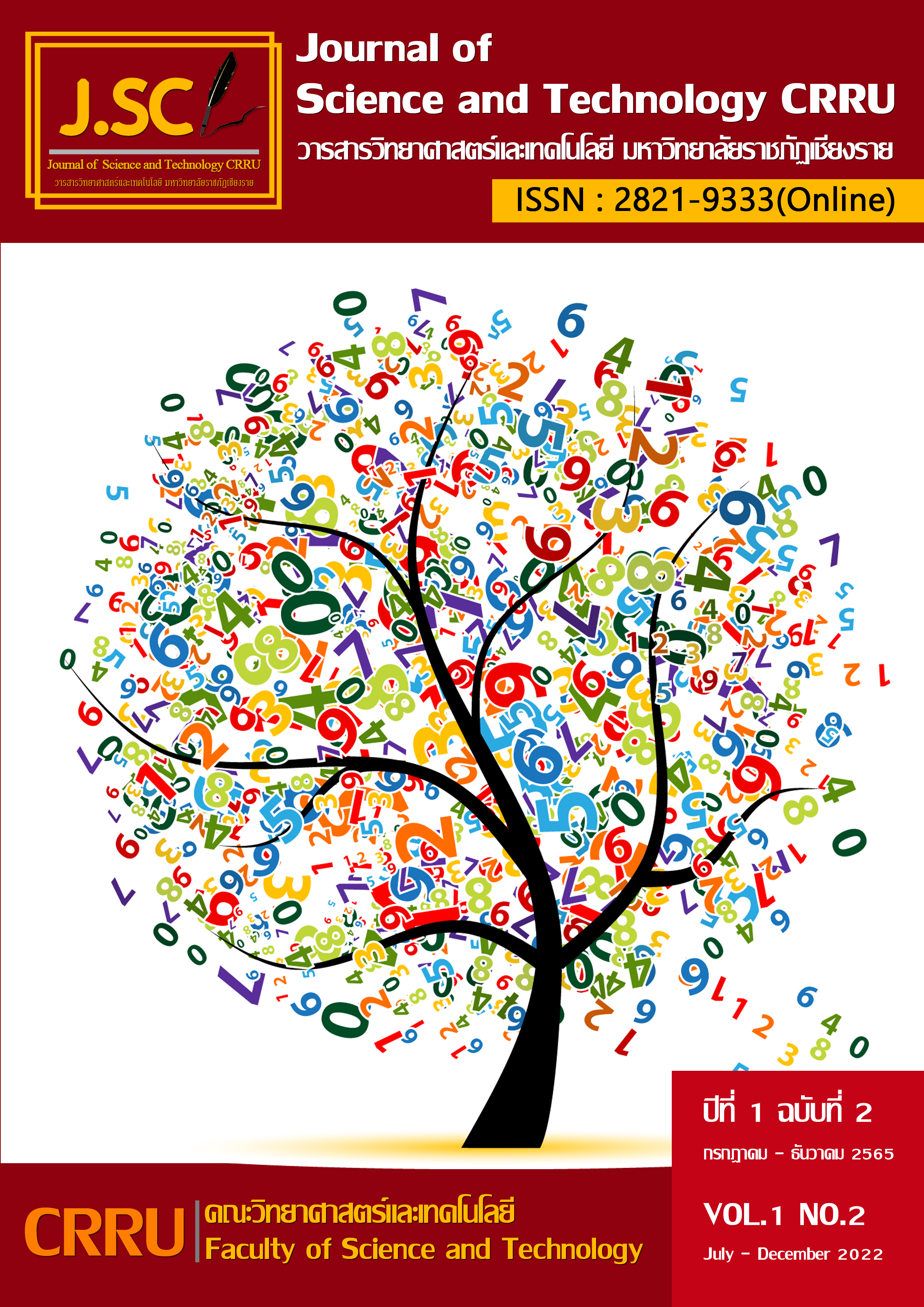Salmonella spp. Contamination in Ice Milk Tea and Ice Coffee from Refreshment Shop Around Kamphaeng Phet Rajabhat University
Main Article Content
Abstract
Iced milk tea and iced coffee at five refreshment shops around Kamphaeng Phet Rajabhat University were examined for possible Salmonella spp. contamination during the period between September and November 2019. It was found that the percentage of the total of 60 samples was 30 percent containing Salmonella spp. which were isolated and identified by biochemically tested for 18 isolates. A sampling isolate, identified based on 16S rRNA gene sequencing, was Salmonella enterica so this confirmation of all isolates was Salmonella spp.. The prevalence of Salmonella spp. in iced milk tea and iced coffee was 18.33 percent, and 11.67 percent respectively. All 18 isolates were tested for their antimicrobial susceptibility pattern by disk diffusion technique. These Isolated resistant to many drugs which pose a risk to consumers.
Article Details

This work is licensed under a Creative Commons Attribution-NonCommercial-NoDerivatives 4.0 International License.
Journal of TCI is licensed under a Creative Commons Attribution-NonCommercial-NoDerivatives 4.0 International (CC BY-NC-ND 4.0)
References
Food Microbiology Targeted Surveys. (2020). Bacterial Pathogens in Cold Brewed Coffee - April 1, 2018 to March 31, 2019. Canadian Food Inspection Agency.
ภัทรชัย กีรติสิน. (2549). ตำราวิทยาแบคทีเรียการแพทย์. พิมพ์ครั้งที่ 1. กรุงเทพฯ: ภาควิชาจุลชีววิทยา คณะแพทยศาสตร์ศิริราชพยาบาล มหาวิทยาลัยมหิดล.
Waturangi, D.E., Wiratama, E., & Theresia, A.S. (2019) Prevalence and molecular characterization of Salmonella enterica serovar Typhimurium from ice and beverages in Jakarta, Indonesia. BMC Research Notes, 12(1), 45.
ISO 6579 - 1:2017. Microbiology of the food chain - horizontal method for the detection, enumeration and serotyping of Salmonella - Part 1: detection of Salmonella spp. Geneva, Switzerland: International Organization for Standardization; 2017.
Magiorakos, A.P., Srinivasan, A., Carey, R. B., & Carmeli, Y. (2012). Multidrug-resistant, extensively drug-resistant and pandrugresistant bacteria: an international expert proposal for interim standard definitions foracquired resistance. Clinical Microbiology and Infection, 18(3), 268–281.
Greene, S. K., Daly, E. R., Talbot, E. A., Demma, L. J., Holzbauer, S., Patel, N. J.,. H ill T.A., Walderhaug M.O., Hoekstra R. M., Lynch M.F., & Painter J.A. (2008). Recurrent multistate outbreak of Salmonella Newport associated with tomatoes from contaminated fields, 2005. Epidemiology and Infection, 136(2), 157–165.
Sivapalasingam, S., Barrett, E., Kimura, A., Van Duyne, S., De Witt, W., Ying, M., Frisch A., Phan, Q., Gould, E., Shillam, P., Reddy V., Cooper, T., Hoekstra M., Higgins, C., Sanders, J.P., Tauxe R.V., & Slutsker L. (2003). A multistate outbreak of Salmonella enterica Serotype Newport infection linked to mango consumption: Impact of water-dip disinfestation technology. Clinical Infectious Diseases, 37(12), 1585–1590.
Kateryn, R. (2003). Persistence and Significance of E. coli in House Flies (Musca domestica) and Stable Flies (Stomoxys calcitrans). Master’s Thesis, University of Lethbridge, Lethbridge, AB, Canada.
Alimi, B.A. (2016). Risk factors in street food practices in developing countries. Food Science and Human Wellness, 5(3), 141–148.
Sayah, R.S., Kaneene, J.B., Johnson, Y., & Miller, R.A. (2005). Patterns of antimicrobial resistance observed in Escherichia coli isolates obtained from domestic and wild animal fecal samples, human septage, and surface water. Applied and Environmental Microbiology, 71(3), 1394-1404.
Winokur, P. L., Vonstein, D. L, Hoffman, L. J., Uhlenhopp, E. K., & Doern, G. V. (2001). Evidence for transfer of CMY-2 AmpC-lactamase plasmids between Escherichia coli and Salmonella isolates from food animals and humans. Antimicrob Agents Chemother, 45(10), 2716–2722.
Melissa, O. (2004). Transfer of Antibiotic resistant Genes between Escherichia coli and Salmonella Typhimurum. Cantaurus, 12, 13-14.
Tortora, G. J., Funke, B. R., & Case, C.L. (1992). Microbiology: An Introduction. California: The Benjamin/Cummings.
Oloso, N.O., Adeyemo, I.A., Heerden, H.V., Fasanmi, O.G., & Fasina, F.O. (2019). Antimicrobial Drug Administration and Antimicrobial from the Broiler Production Value Chain in Nigeria. Antibiotics 2019, 8(2), 75.
Cardinale, E., Perrier Gros-Claude, J.D., Rivoal, K., Ros,e V., Tall, F., Mead G.C., & Salvat, G. (2005). Epidemiological analysis of Salmonella enterica ssp. Enterica serovars Hadar, Brancaster and Enteritidis from humans and broiler chickens in Senegal using pulsed-field gel electrophoresis and antibiotic susceptibility. Journal of Applied Microbiology, 99(4). 968-977.


